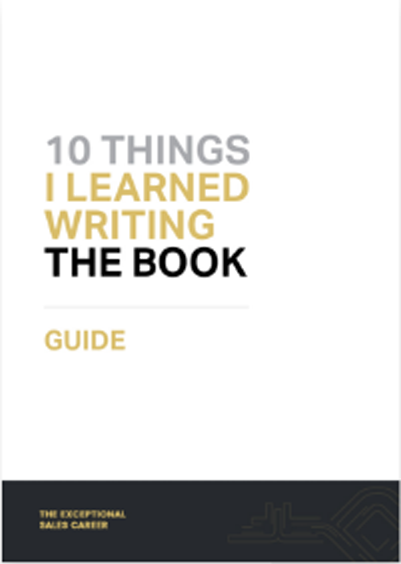I knew Sugato’s name from my time at Gartner, where I had seen a case study of National Instruments, where he was Global Head of Key Accounts and Sales Excellence. Gartner (or CEB at the time) had profiled National Instruments for its structured approach to sales, including helping its customers understand their business problems through quantifying their biggest strategic opportunities. I was therefore very excited when Sugato accepted my request to interview him.
Sugato’s interview was thoughtful, considered, and insightful, as you’ll see below.
You can read Sugato’s full biography here
Jamie: Sugato, in your career in sales consultancy and research/advisory, what have you found most fulfilling?
Sugato: Empowering your customers to change their work, and helping your customer be successful in their world. From the roles I’ve had, those are the parts where you feel you are bringing something unique. Sales has the closest interface to the customer; having a vision of what they are going to create and how you empower them to go on that journey is fulfilling.
Jamie: How did you choose sales as a function?
Sugato: I migrated into sales, but my career has gone full circle. Starting out my career as an engineer, I made products, which included purchasing a lot of technology, and that was my first connection with sales. Over time, I moved into management consulting, which again, relies on finding out how customers think. Regarding marketing, I try to better position our products during the discovery process of how the customers will really use our products and services to create their business.
Sales is going through a major progression from the previous generation of sales profiles, or the expectation that sales is essentially trying to promote your products and services, with the priority in getting revenue from customers and now towards a more future-looking discipline. The future is more about understanding what value your products and services create for you and your customers, and how you can best position your products. For companies producing products, they tend to be very conversive with those products’ services and features but don’t understand well how customers use them to generate value. I go back to my early experience developing products, when salespeople would come to me, I would ask, “Have you taken the time to understand the business and technical issues we face and how your product solves them?”
If I don’t have these questions addressed, then as a customer, I will need to put a lot of effort into figuring out if it’ll really be useful in our work. However, if the salesperson has taken the initative and picked up on most of our issues, then they’re going to have a lot of credibility, and the assimilation will be faster and more valuable to me as a customer.
When a seller puts themselves in the shoes of their customer, seeing the world through their eyes, sales and revenue will follow.
Jamie: Do you think it gave you a competitive advantage as a salesperson to have been on the other side of the table as a buyer?
Sugato: As salespeople, we can see situations that the customer hasn’t considered due to our experience with other interactions. We need to understand our customers and then start by asking, “Why?” Simon Sinek has a valuable lesson on asking, “why, how, and what.” I have found that most salespeople don’t spend enough time on the “why.”
Customers have symptoms, and they want to rush to a solution. As a salesperson, we see, “Jumping into this solution means I can sell my product, it seems like a good alignment, let’s go through a few problem statements and then we’ll figure out how our products can solve the problem.” However, this can inadvertently catch up with you later on in the sales cycle.
I think the future of sales, or at least more of the complex sales, will go in the direction of having critical thinking capabilities in your organization, thinking more and being a collaborator, somebody who can bring organizations together.
I think COVID is changing the perception that “this is a relationship” that some have been selling in the past. I think it is changing more into a value-based relationship. The customer doesn’t need to be best buddies with my salesperson.
Jamie: Which skills are more necessary in salespeople now than they have ever been before?
Sugato: I think critical thinking, and being more comfortable with risk in a product selling organization – you are the salesperson, you have all the knowledge of products and services. It is easy to go to a customer and say, “My product does XYZ.” It disregards the situation, which is that the customer holds most of the knowledge about the problem their product solves. The customer understands the problem, and it is up to the salesperson to extract answers and show how they can add value.
Another good skill is acting in the role of the collaborator, or the facilitator in bringing people together, whether it is inside your organization or helping the customers’ organization build consensus. This will be increasingly valued. These softer skills will be a big part of what the next generation of sales requires.
The product and features demos are now becoming more readily available to customers on websites. They’ll go to our website and look at our customer discussions, trying to get an agnostic view of their supplier.
Jamie: What characteristics do you look for in a salesperson, and how can you test for them?
Sugato: Things like critical thinking and collaboration. It has been suggested before that these could be assessed with a standardized test. However, I am highly doubtful of that, as it has more to do with experience. When I hire people for my team, I’ll use real-life scenarios presenting a situation than seeing how they apply their critical thinking to break down what is a complex topic and then if they can present it in a structured way.
The other part, which is harder to measure, is how good of a facilitator you are. These things can be taught to an extent, but I think cohesiveness is just part of your profile, and I can sense that by questioning, looking at the type of engagements you have planned in your sales career, your failures, trying to do something that was outspoken or irresponsible. The softer skills can be worked on to become a successful salesperson.
Jamie: What would be the specific elements of a sales enablement program that you would look for in your next organization?
Sugato: There were three areas we focused on topping up, in partnership with the senior salespeople. The first part was, “How do I go into an account and figure out what is the best place for me to focus on?” The second part focused on, “How do I now engage with the customer in the best way to understand what their business problems are?” And the third part – which is normally towards the end of that whole process – developing past the status quo to better approach things in the future, using feedback such as, “What are the business’ playbooks?” which in turn can answer questions such as, “Why do we want to change?” and “How do you even bring different groups of people together?” This will enable the sales team to add further value with better processes.
Jamie: How do you recommend organizations best compensate their salespeople?
Sugato: That’s generally not in my thought process, but compensation should not get in the way of a salesperson doing the right thing.
Jamie: What does that organization need to have in terms of culture for you who want to join?
Sugato: I think transparency is the biggest thing I appreciate. I have worked in many organizations, and it is hard to get transparency. By transparency, I mean not just what people say, but in their actions and behaviour. But it is hard to determine this until you are in the organization.
Jamie: From the outside looking in, are there any ways which you can test for that transparency?
Sugato: Transparency can be tested in how accessible people in these roles are: how difficult the search for them was, and will their colleagues participate? Can they go all the way up the chain of command? Do they feel empowered? How are they measured and held accountable? So, in a large part, how empowered the front-line people are.
Jamie: What is the best piece of advice you would give an aspiring salesperson?
Sugato: I think the world is changing for the better– so look forward to where the path is leading and what skills you’ll need to be successful there. If this future excites you, get into sales.
It’s going through a period of transition now and sales will function differently in the future. I would want you to aspire and say, “I want to be a next-generation salesperson.” The reality is that the next generation salesperson of the future is already here. A lot of top companies have already moved in that direction. So, if you are not aligned with that perspective, just rethink the best place for you to be in the future.
Jamie: If you had your sales career again, what would you do differently?
Sugato: There are lots of things in hindsight but as an organization, taking more risk, putting in more work upfront, and scaling faster were some of the things that we could have done much better.
Jamie: What is the single piece of research on sales that you have read that has impacted you the most?
Sugato:
I think the single piece of research was the one by CEB/Gartner, that customers are 57% of their way through a purchase before they have contact with the seller. This wasn’t aligned with my thinking at the time; that sales is essentially a reactive force after the customer has figured out what they want.
But it also opened up the question regarding what was happening during that 0% to 57% period, and how participation in that period by sales can be much more effective, and it changed a lot of mindsets including the approach of some multi-national companies.
We weren’t doing enough at the start of the customer’s process, which is the ideal place for sales. What we discovered along the way was how ideas float around an organization and at some point, a “go/no-go” decision is made regarding the idea by the customer’s organization, often without sales being engaged. So, if you’re actively involved with the customer, it will make a huge difference, being a pro-active seller in that 0-57% time period, rather than a reactive one after the 57%. We became more successful by engaging customers early with insight, our win rates improved and our close times reduced, because we were able to accelerate their approach to the change journey, and we were able to back it up with real data over time.
[End]
Connect with Dr. Deb on LINKEDIN



